Applied Leadership and Management Report: Tower Insurance Performance
VerifiedAdded on 2022/08/25
|10
|3367
|22
Report
AI Summary
This report provides an in-depth analysis of applied leadership and performance management within the context of Tower Insurance. It begins by identifying democratic leadership as a suitable approach for addressing performance issues of a new employee, Sophie, who recently migrated from China. The report then explores various performance management approaches, including the use of frequent feedback and real-time data analysis, to improve employee performance. It also discusses the importance of a coaching process, outlining steps such as assessing progress, setting goals, overcoming obstacles, and developing an action plan. Two performance management tools, 360-degree feedback and management by objectives (MBO), are evaluated in conjunction with Hertzberg’s Two-Factor Theory of motivation to enhance employee engagement. The report further examines professional, ethical, cultural, and social issues, such as providing repetitive chances, reduced company productivity, and cultural integration challenges, proposing strategies that align with the Treaty of Waitangi and Maori cultural values. Finally, it analyzes the alignment of performance management systems with Tower Insurance's goals.
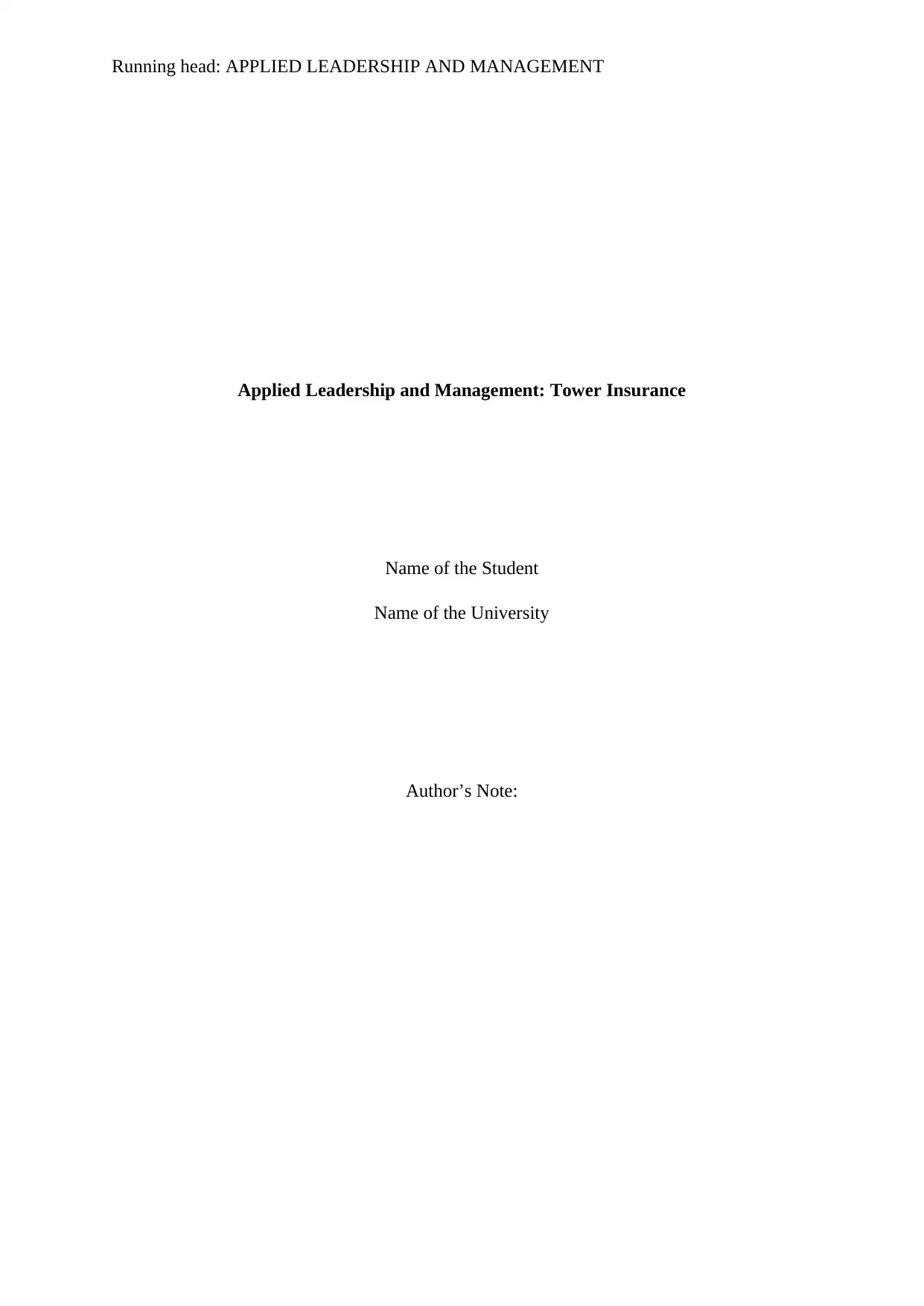
Running head: APPLIED LEADERSHIP AND MANAGEMENT
Applied Leadership and Management: Tower Insurance
Name of the Student
Name of the University
Author’s Note:
Applied Leadership and Management: Tower Insurance
Name of the Student
Name of the University
Author’s Note:
Paraphrase This Document
Need a fresh take? Get an instant paraphrase of this document with our AI Paraphraser
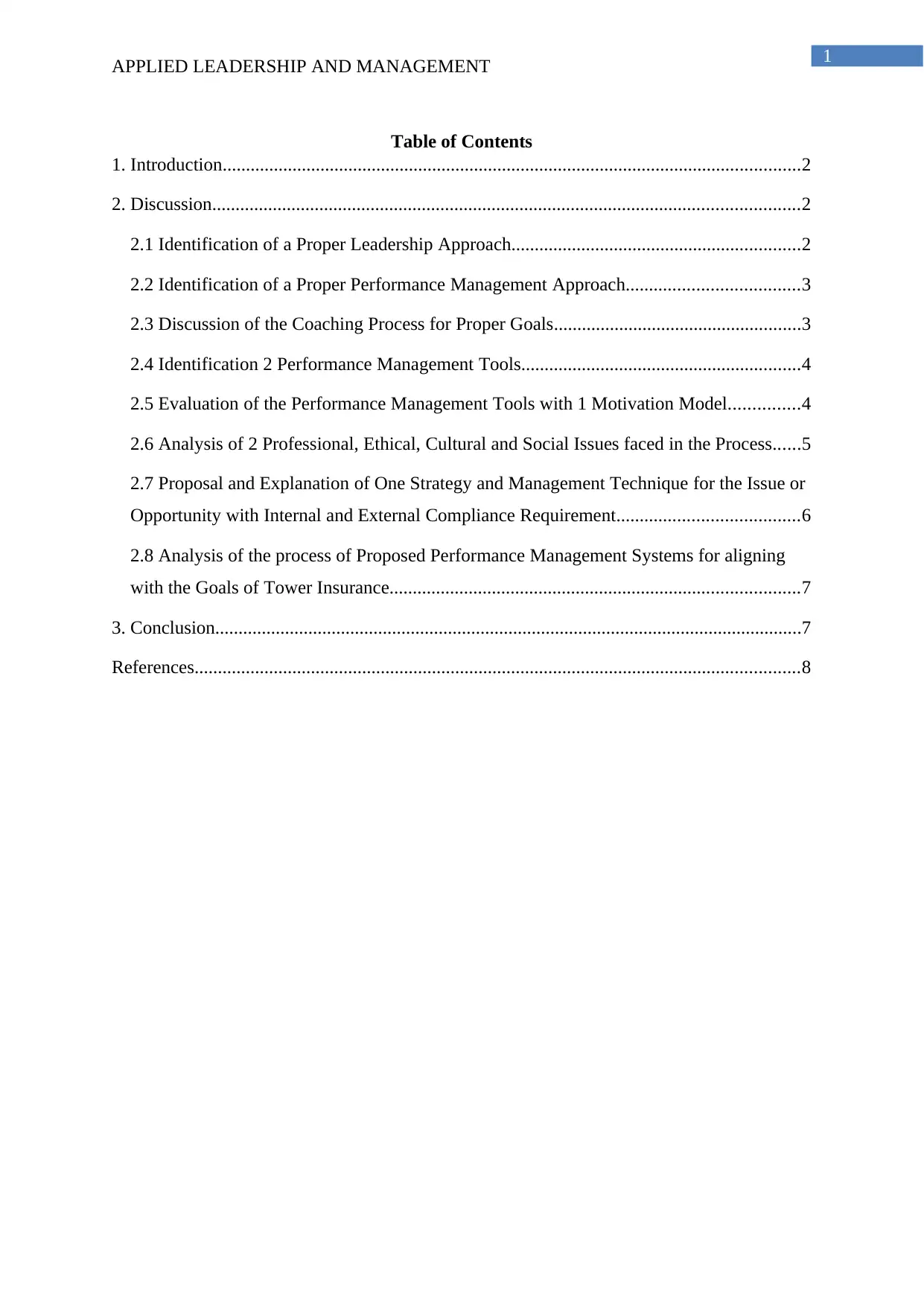
1
APPLIED LEADERSHIP AND MANAGEMENT
Table of Contents
1. Introduction............................................................................................................................2
2. Discussion..............................................................................................................................2
2.1 Identification of a Proper Leadership Approach..............................................................2
2.2 Identification of a Proper Performance Management Approach.....................................3
2.3 Discussion of the Coaching Process for Proper Goals.....................................................3
2.4 Identification 2 Performance Management Tools............................................................4
2.5 Evaluation of the Performance Management Tools with 1 Motivation Model...............4
2.6 Analysis of 2 Professional, Ethical, Cultural and Social Issues faced in the Process......5
2.7 Proposal and Explanation of One Strategy and Management Technique for the Issue or
Opportunity with Internal and External Compliance Requirement.......................................6
2.8 Analysis of the process of Proposed Performance Management Systems for aligning
with the Goals of Tower Insurance........................................................................................7
3. Conclusion..............................................................................................................................7
References..................................................................................................................................8
APPLIED LEADERSHIP AND MANAGEMENT
Table of Contents
1. Introduction............................................................................................................................2
2. Discussion..............................................................................................................................2
2.1 Identification of a Proper Leadership Approach..............................................................2
2.2 Identification of a Proper Performance Management Approach.....................................3
2.3 Discussion of the Coaching Process for Proper Goals.....................................................3
2.4 Identification 2 Performance Management Tools............................................................4
2.5 Evaluation of the Performance Management Tools with 1 Motivation Model...............4
2.6 Analysis of 2 Professional, Ethical, Cultural and Social Issues faced in the Process......5
2.7 Proposal and Explanation of One Strategy and Management Technique for the Issue or
Opportunity with Internal and External Compliance Requirement.......................................6
2.8 Analysis of the process of Proposed Performance Management Systems for aligning
with the Goals of Tower Insurance........................................................................................7
3. Conclusion..............................................................................................................................7
References..................................................................................................................................8
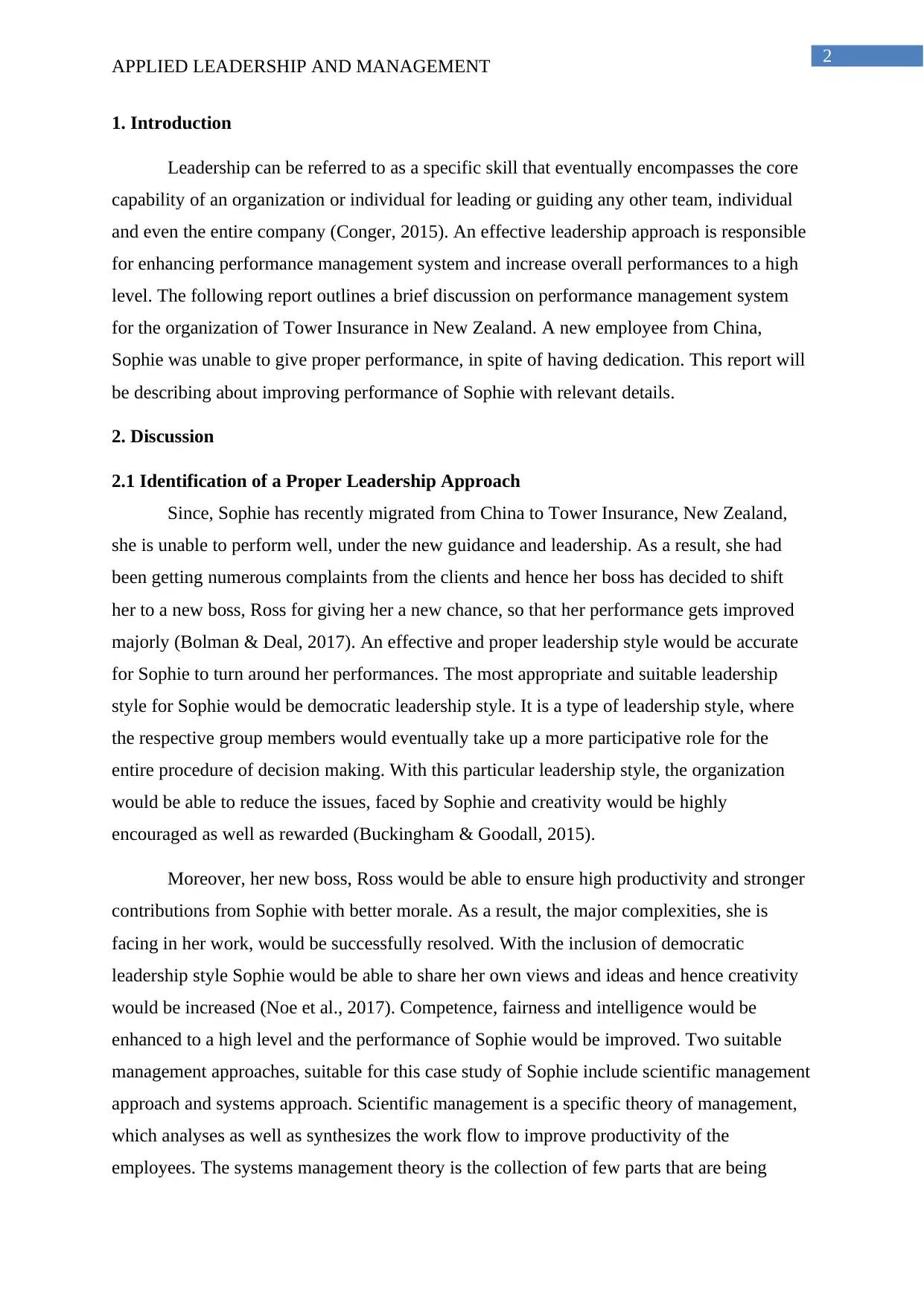
2
APPLIED LEADERSHIP AND MANAGEMENT
1. Introduction
Leadership can be referred to as a specific skill that eventually encompasses the core
capability of an organization or individual for leading or guiding any other team, individual
and even the entire company (Conger, 2015). An effective leadership approach is responsible
for enhancing performance management system and increase overall performances to a high
level. The following report outlines a brief discussion on performance management system
for the organization of Tower Insurance in New Zealand. A new employee from China,
Sophie was unable to give proper performance, in spite of having dedication. This report will
be describing about improving performance of Sophie with relevant details.
2. Discussion
2.1 Identification of a Proper Leadership Approach
Since, Sophie has recently migrated from China to Tower Insurance, New Zealand,
she is unable to perform well, under the new guidance and leadership. As a result, she had
been getting numerous complaints from the clients and hence her boss has decided to shift
her to a new boss, Ross for giving her a new chance, so that her performance gets improved
majorly (Bolman & Deal, 2017). An effective and proper leadership style would be accurate
for Sophie to turn around her performances. The most appropriate and suitable leadership
style for Sophie would be democratic leadership style. It is a type of leadership style, where
the respective group members would eventually take up a more participative role for the
entire procedure of decision making. With this particular leadership style, the organization
would be able to reduce the issues, faced by Sophie and creativity would be highly
encouraged as well as rewarded (Buckingham & Goodall, 2015).
Moreover, her new boss, Ross would be able to ensure high productivity and stronger
contributions from Sophie with better morale. As a result, the major complexities, she is
facing in her work, would be successfully resolved. With the inclusion of democratic
leadership style Sophie would be able to share her own views and ideas and hence creativity
would be increased (Noe et al., 2017). Competence, fairness and intelligence would be
enhanced to a high level and the performance of Sophie would be improved. Two suitable
management approaches, suitable for this case study of Sophie include scientific management
approach and systems approach. Scientific management is a specific theory of management,
which analyses as well as synthesizes the work flow to improve productivity of the
employees. The systems management theory is the collection of few parts that are being
APPLIED LEADERSHIP AND MANAGEMENT
1. Introduction
Leadership can be referred to as a specific skill that eventually encompasses the core
capability of an organization or individual for leading or guiding any other team, individual
and even the entire company (Conger, 2015). An effective leadership approach is responsible
for enhancing performance management system and increase overall performances to a high
level. The following report outlines a brief discussion on performance management system
for the organization of Tower Insurance in New Zealand. A new employee from China,
Sophie was unable to give proper performance, in spite of having dedication. This report will
be describing about improving performance of Sophie with relevant details.
2. Discussion
2.1 Identification of a Proper Leadership Approach
Since, Sophie has recently migrated from China to Tower Insurance, New Zealand,
she is unable to perform well, under the new guidance and leadership. As a result, she had
been getting numerous complaints from the clients and hence her boss has decided to shift
her to a new boss, Ross for giving her a new chance, so that her performance gets improved
majorly (Bolman & Deal, 2017). An effective and proper leadership style would be accurate
for Sophie to turn around her performances. The most appropriate and suitable leadership
style for Sophie would be democratic leadership style. It is a type of leadership style, where
the respective group members would eventually take up a more participative role for the
entire procedure of decision making. With this particular leadership style, the organization
would be able to reduce the issues, faced by Sophie and creativity would be highly
encouraged as well as rewarded (Buckingham & Goodall, 2015).
Moreover, her new boss, Ross would be able to ensure high productivity and stronger
contributions from Sophie with better morale. As a result, the major complexities, she is
facing in her work, would be successfully resolved. With the inclusion of democratic
leadership style Sophie would be able to share her own views and ideas and hence creativity
would be increased (Noe et al., 2017). Competence, fairness and intelligence would be
enhanced to a high level and the performance of Sophie would be improved. Two suitable
management approaches, suitable for this case study of Sophie include scientific management
approach and systems approach. Scientific management is a specific theory of management,
which analyses as well as synthesizes the work flow to improve productivity of the
employees. The systems management theory is the collection of few parts that are being
⊘ This is a preview!⊘
Do you want full access?
Subscribe today to unlock all pages.

Trusted by 1+ million students worldwide
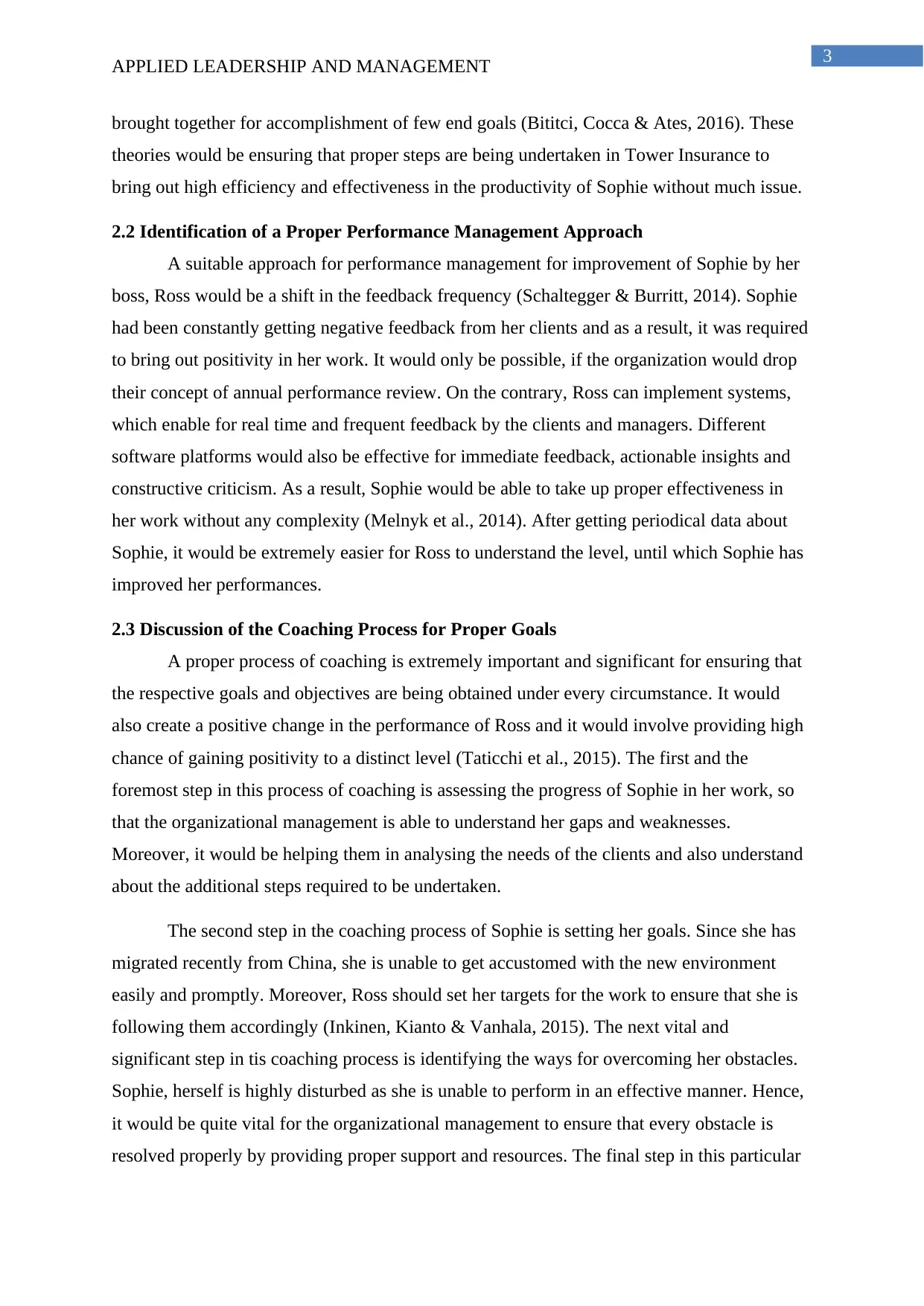
3
APPLIED LEADERSHIP AND MANAGEMENT
brought together for accomplishment of few end goals (Bititci, Cocca & Ates, 2016). These
theories would be ensuring that proper steps are being undertaken in Tower Insurance to
bring out high efficiency and effectiveness in the productivity of Sophie without much issue.
2.2 Identification of a Proper Performance Management Approach
A suitable approach for performance management for improvement of Sophie by her
boss, Ross would be a shift in the feedback frequency (Schaltegger & Burritt, 2014). Sophie
had been constantly getting negative feedback from her clients and as a result, it was required
to bring out positivity in her work. It would only be possible, if the organization would drop
their concept of annual performance review. On the contrary, Ross can implement systems,
which enable for real time and frequent feedback by the clients and managers. Different
software platforms would also be effective for immediate feedback, actionable insights and
constructive criticism. As a result, Sophie would be able to take up proper effectiveness in
her work without any complexity (Melnyk et al., 2014). After getting periodical data about
Sophie, it would be extremely easier for Ross to understand the level, until which Sophie has
improved her performances.
2.3 Discussion of the Coaching Process for Proper Goals
A proper process of coaching is extremely important and significant for ensuring that
the respective goals and objectives are being obtained under every circumstance. It would
also create a positive change in the performance of Ross and it would involve providing high
chance of gaining positivity to a distinct level (Taticchi et al., 2015). The first and the
foremost step in this process of coaching is assessing the progress of Sophie in her work, so
that the organizational management is able to understand her gaps and weaknesses.
Moreover, it would be helping them in analysing the needs of the clients and also understand
about the additional steps required to be undertaken.
The second step in the coaching process of Sophie is setting her goals. Since she has
migrated recently from China, she is unable to get accustomed with the new environment
easily and promptly. Moreover, Ross should set her targets for the work to ensure that she is
following them accordingly (Inkinen, Kianto & Vanhala, 2015). The next vital and
significant step in tis coaching process is identifying the ways for overcoming her obstacles.
Sophie, herself is highly disturbed as she is unable to perform in an effective manner. Hence,
it would be quite vital for the organizational management to ensure that every obstacle is
resolved properly by providing proper support and resources. The final step in this particular
APPLIED LEADERSHIP AND MANAGEMENT
brought together for accomplishment of few end goals (Bititci, Cocca & Ates, 2016). These
theories would be ensuring that proper steps are being undertaken in Tower Insurance to
bring out high efficiency and effectiveness in the productivity of Sophie without much issue.
2.2 Identification of a Proper Performance Management Approach
A suitable approach for performance management for improvement of Sophie by her
boss, Ross would be a shift in the feedback frequency (Schaltegger & Burritt, 2014). Sophie
had been constantly getting negative feedback from her clients and as a result, it was required
to bring out positivity in her work. It would only be possible, if the organization would drop
their concept of annual performance review. On the contrary, Ross can implement systems,
which enable for real time and frequent feedback by the clients and managers. Different
software platforms would also be effective for immediate feedback, actionable insights and
constructive criticism. As a result, Sophie would be able to take up proper effectiveness in
her work without any complexity (Melnyk et al., 2014). After getting periodical data about
Sophie, it would be extremely easier for Ross to understand the level, until which Sophie has
improved her performances.
2.3 Discussion of the Coaching Process for Proper Goals
A proper process of coaching is extremely important and significant for ensuring that
the respective goals and objectives are being obtained under every circumstance. It would
also create a positive change in the performance of Ross and it would involve providing high
chance of gaining positivity to a distinct level (Taticchi et al., 2015). The first and the
foremost step in this process of coaching is assessing the progress of Sophie in her work, so
that the organizational management is able to understand her gaps and weaknesses.
Moreover, it would be helping them in analysing the needs of the clients and also understand
about the additional steps required to be undertaken.
The second step in the coaching process of Sophie is setting her goals. Since she has
migrated recently from China, she is unable to get accustomed with the new environment
easily and promptly. Moreover, Ross should set her targets for the work to ensure that she is
following them accordingly (Inkinen, Kianto & Vanhala, 2015). The next vital and
significant step in tis coaching process is identifying the ways for overcoming her obstacles.
Sophie, herself is highly disturbed as she is unable to perform in an effective manner. Hence,
it would be quite vital for the organizational management to ensure that every obstacle is
resolved properly by providing proper support and resources. The final step in this particular
Paraphrase This Document
Need a fresh take? Get an instant paraphrase of this document with our AI Paraphraser
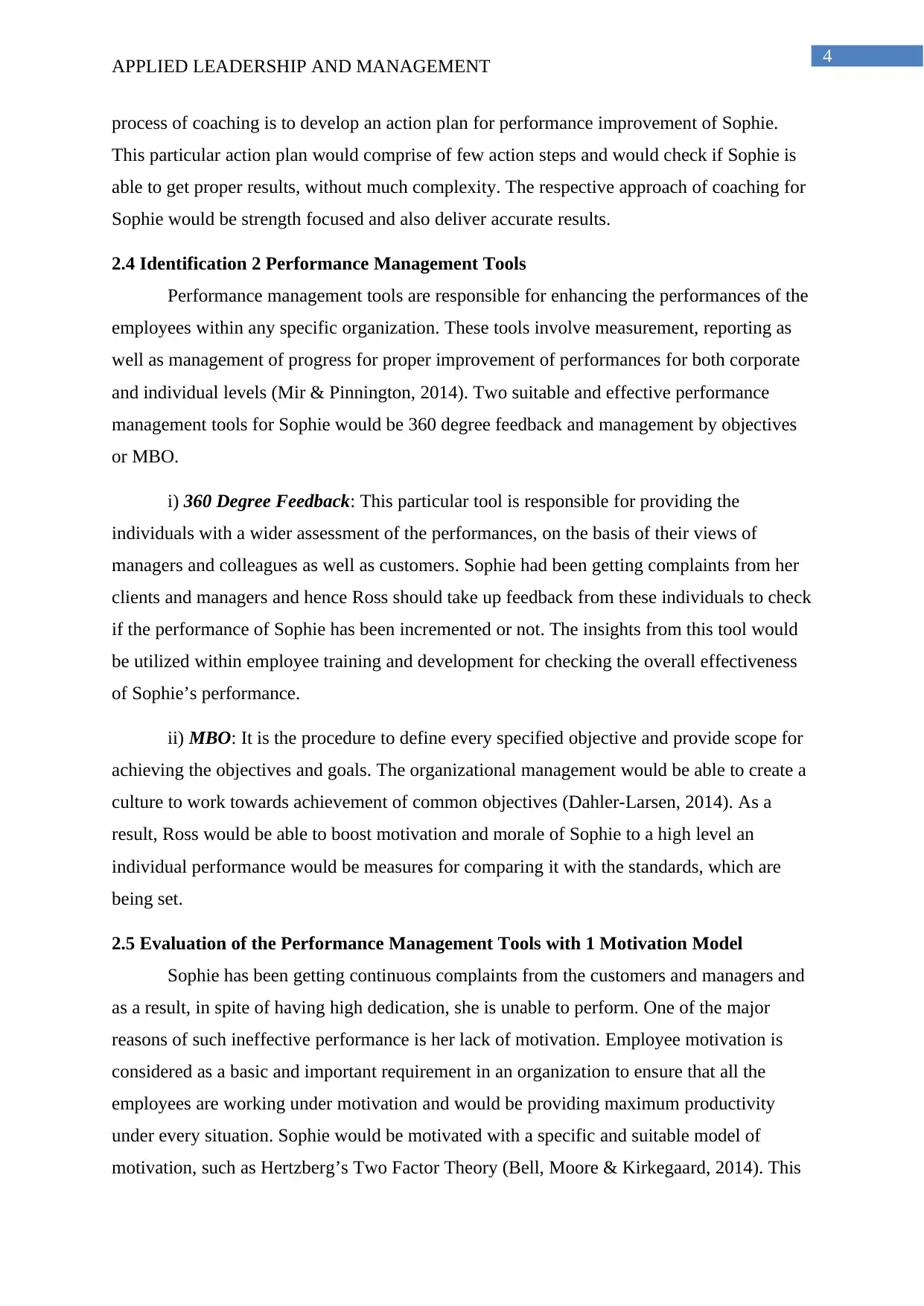
4
APPLIED LEADERSHIP AND MANAGEMENT
process of coaching is to develop an action plan for performance improvement of Sophie.
This particular action plan would comprise of few action steps and would check if Sophie is
able to get proper results, without much complexity. The respective approach of coaching for
Sophie would be strength focused and also deliver accurate results.
2.4 Identification 2 Performance Management Tools
Performance management tools are responsible for enhancing the performances of the
employees within any specific organization. These tools involve measurement, reporting as
well as management of progress for proper improvement of performances for both corporate
and individual levels (Mir & Pinnington, 2014). Two suitable and effective performance
management tools for Sophie would be 360 degree feedback and management by objectives
or MBO.
i) 360 Degree Feedback: This particular tool is responsible for providing the
individuals with a wider assessment of the performances, on the basis of their views of
managers and colleagues as well as customers. Sophie had been getting complaints from her
clients and managers and hence Ross should take up feedback from these individuals to check
if the performance of Sophie has been incremented or not. The insights from this tool would
be utilized within employee training and development for checking the overall effectiveness
of Sophie’s performance.
ii) MBO: It is the procedure to define every specified objective and provide scope for
achieving the objectives and goals. The organizational management would be able to create a
culture to work towards achievement of common objectives (Dahler-Larsen, 2014). As a
result, Ross would be able to boost motivation and morale of Sophie to a high level an
individual performance would be measures for comparing it with the standards, which are
being set.
2.5 Evaluation of the Performance Management Tools with 1 Motivation Model
Sophie has been getting continuous complaints from the customers and managers and
as a result, in spite of having high dedication, she is unable to perform. One of the major
reasons of such ineffective performance is her lack of motivation. Employee motivation is
considered as a basic and important requirement in an organization to ensure that all the
employees are working under motivation and would be providing maximum productivity
under every situation. Sophie would be motivated with a specific and suitable model of
motivation, such as Hertzberg’s Two Factor Theory (Bell, Moore & Kirkegaard, 2014). This
APPLIED LEADERSHIP AND MANAGEMENT
process of coaching is to develop an action plan for performance improvement of Sophie.
This particular action plan would comprise of few action steps and would check if Sophie is
able to get proper results, without much complexity. The respective approach of coaching for
Sophie would be strength focused and also deliver accurate results.
2.4 Identification 2 Performance Management Tools
Performance management tools are responsible for enhancing the performances of the
employees within any specific organization. These tools involve measurement, reporting as
well as management of progress for proper improvement of performances for both corporate
and individual levels (Mir & Pinnington, 2014). Two suitable and effective performance
management tools for Sophie would be 360 degree feedback and management by objectives
or MBO.
i) 360 Degree Feedback: This particular tool is responsible for providing the
individuals with a wider assessment of the performances, on the basis of their views of
managers and colleagues as well as customers. Sophie had been getting complaints from her
clients and managers and hence Ross should take up feedback from these individuals to check
if the performance of Sophie has been incremented or not. The insights from this tool would
be utilized within employee training and development for checking the overall effectiveness
of Sophie’s performance.
ii) MBO: It is the procedure to define every specified objective and provide scope for
achieving the objectives and goals. The organizational management would be able to create a
culture to work towards achievement of common objectives (Dahler-Larsen, 2014). As a
result, Ross would be able to boost motivation and morale of Sophie to a high level an
individual performance would be measures for comparing it with the standards, which are
being set.
2.5 Evaluation of the Performance Management Tools with 1 Motivation Model
Sophie has been getting continuous complaints from the customers and managers and
as a result, in spite of having high dedication, she is unable to perform. One of the major
reasons of such ineffective performance is her lack of motivation. Employee motivation is
considered as a basic and important requirement in an organization to ensure that all the
employees are working under motivation and would be providing maximum productivity
under every situation. Sophie would be motivated with a specific and suitable model of
motivation, such as Hertzberg’s Two Factor Theory (Bell, Moore & Kirkegaard, 2014). This
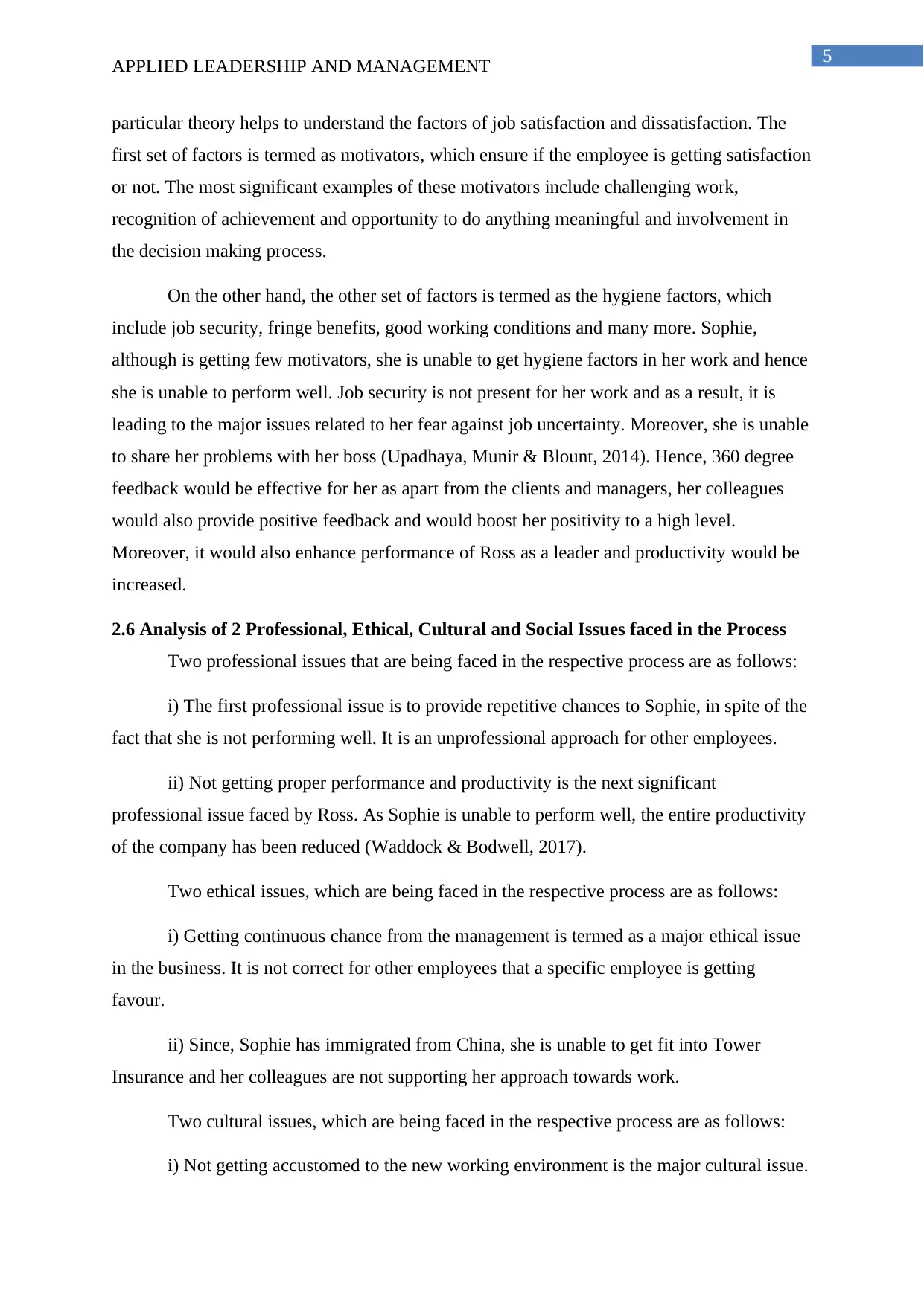
5
APPLIED LEADERSHIP AND MANAGEMENT
particular theory helps to understand the factors of job satisfaction and dissatisfaction. The
first set of factors is termed as motivators, which ensure if the employee is getting satisfaction
or not. The most significant examples of these motivators include challenging work,
recognition of achievement and opportunity to do anything meaningful and involvement in
the decision making process.
On the other hand, the other set of factors is termed as the hygiene factors, which
include job security, fringe benefits, good working conditions and many more. Sophie,
although is getting few motivators, she is unable to get hygiene factors in her work and hence
she is unable to perform well. Job security is not present for her work and as a result, it is
leading to the major issues related to her fear against job uncertainty. Moreover, she is unable
to share her problems with her boss (Upadhaya, Munir & Blount, 2014). Hence, 360 degree
feedback would be effective for her as apart from the clients and managers, her colleagues
would also provide positive feedback and would boost her positivity to a high level.
Moreover, it would also enhance performance of Ross as a leader and productivity would be
increased.
2.6 Analysis of 2 Professional, Ethical, Cultural and Social Issues faced in the Process
Two professional issues that are being faced in the respective process are as follows:
i) The first professional issue is to provide repetitive chances to Sophie, in spite of the
fact that she is not performing well. It is an unprofessional approach for other employees.
ii) Not getting proper performance and productivity is the next significant
professional issue faced by Ross. As Sophie is unable to perform well, the entire productivity
of the company has been reduced (Waddock & Bodwell, 2017).
Two ethical issues, which are being faced in the respective process are as follows:
i) Getting continuous chance from the management is termed as a major ethical issue
in the business. It is not correct for other employees that a specific employee is getting
favour.
ii) Since, Sophie has immigrated from China, she is unable to get fit into Tower
Insurance and her colleagues are not supporting her approach towards work.
Two cultural issues, which are being faced in the respective process are as follows:
i) Not getting accustomed to the new working environment is the major cultural issue.
APPLIED LEADERSHIP AND MANAGEMENT
particular theory helps to understand the factors of job satisfaction and dissatisfaction. The
first set of factors is termed as motivators, which ensure if the employee is getting satisfaction
or not. The most significant examples of these motivators include challenging work,
recognition of achievement and opportunity to do anything meaningful and involvement in
the decision making process.
On the other hand, the other set of factors is termed as the hygiene factors, which
include job security, fringe benefits, good working conditions and many more. Sophie,
although is getting few motivators, she is unable to get hygiene factors in her work and hence
she is unable to perform well. Job security is not present for her work and as a result, it is
leading to the major issues related to her fear against job uncertainty. Moreover, she is unable
to share her problems with her boss (Upadhaya, Munir & Blount, 2014). Hence, 360 degree
feedback would be effective for her as apart from the clients and managers, her colleagues
would also provide positive feedback and would boost her positivity to a high level.
Moreover, it would also enhance performance of Ross as a leader and productivity would be
increased.
2.6 Analysis of 2 Professional, Ethical, Cultural and Social Issues faced in the Process
Two professional issues that are being faced in the respective process are as follows:
i) The first professional issue is to provide repetitive chances to Sophie, in spite of the
fact that she is not performing well. It is an unprofessional approach for other employees.
ii) Not getting proper performance and productivity is the next significant
professional issue faced by Ross. As Sophie is unable to perform well, the entire productivity
of the company has been reduced (Waddock & Bodwell, 2017).
Two ethical issues, which are being faced in the respective process are as follows:
i) Getting continuous chance from the management is termed as a major ethical issue
in the business. It is not correct for other employees that a specific employee is getting
favour.
ii) Since, Sophie has immigrated from China, she is unable to get fit into Tower
Insurance and her colleagues are not supporting her approach towards work.
Two cultural issues, which are being faced in the respective process are as follows:
i) Not getting accustomed to the new working environment is the major cultural issue.
⊘ This is a preview!⊘
Do you want full access?
Subscribe today to unlock all pages.

Trusted by 1+ million students worldwide
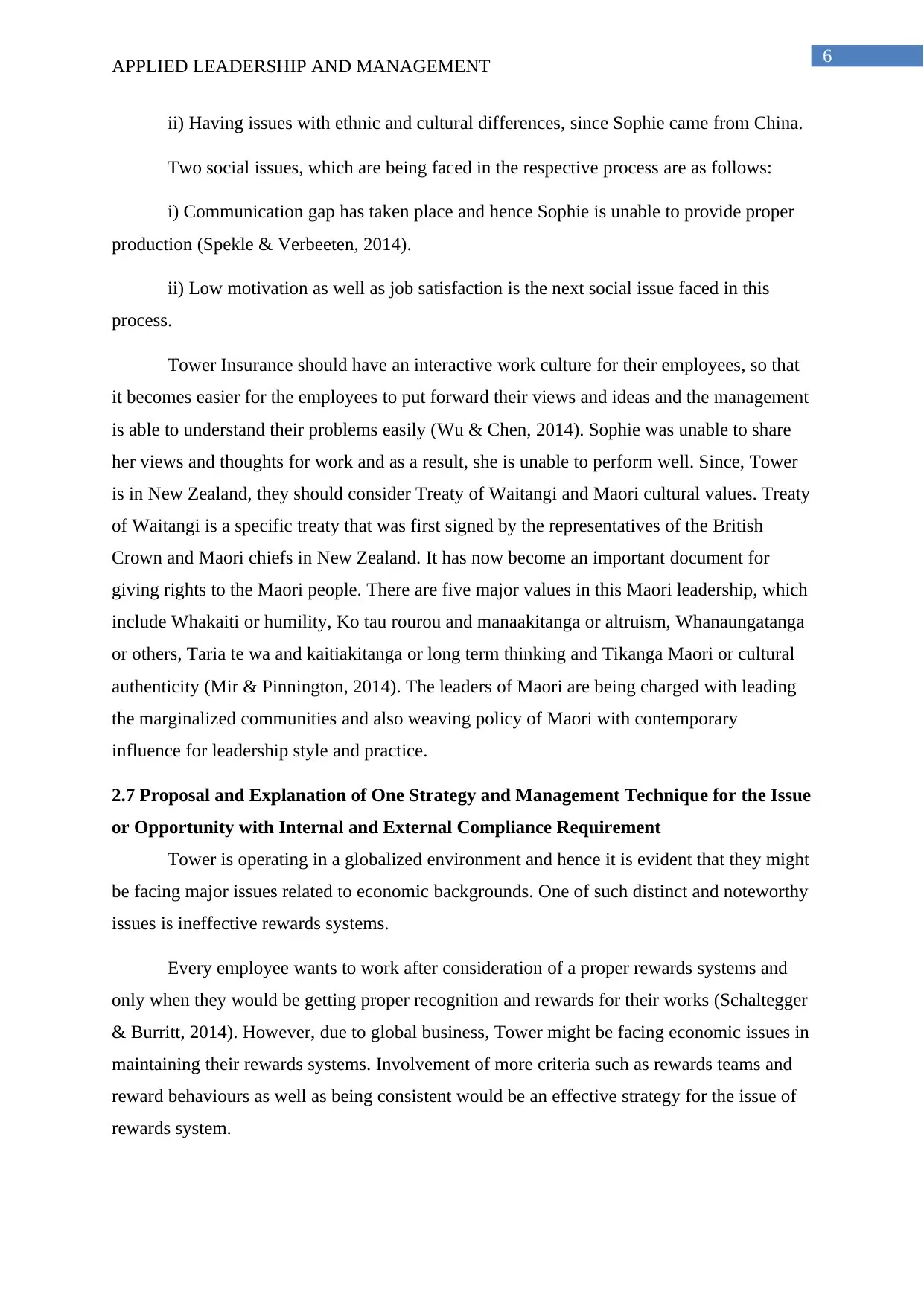
6
APPLIED LEADERSHIP AND MANAGEMENT
ii) Having issues with ethnic and cultural differences, since Sophie came from China.
Two social issues, which are being faced in the respective process are as follows:
i) Communication gap has taken place and hence Sophie is unable to provide proper
production (Spekle & Verbeeten, 2014).
ii) Low motivation as well as job satisfaction is the next social issue faced in this
process.
Tower Insurance should have an interactive work culture for their employees, so that
it becomes easier for the employees to put forward their views and ideas and the management
is able to understand their problems easily (Wu & Chen, 2014). Sophie was unable to share
her views and thoughts for work and as a result, she is unable to perform well. Since, Tower
is in New Zealand, they should consider Treaty of Waitangi and Maori cultural values. Treaty
of Waitangi is a specific treaty that was first signed by the representatives of the British
Crown and Maori chiefs in New Zealand. It has now become an important document for
giving rights to the Maori people. There are five major values in this Maori leadership, which
include Whakaiti or humility, Ko tau rourou and manaakitanga or altruism, Whanaungatanga
or others, Taria te wa and kaitiakitanga or long term thinking and Tikanga Maori or cultural
authenticity (Mir & Pinnington, 2014). The leaders of Maori are being charged with leading
the marginalized communities and also weaving policy of Maori with contemporary
influence for leadership style and practice.
2.7 Proposal and Explanation of One Strategy and Management Technique for the Issue
or Opportunity with Internal and External Compliance Requirement
Tower is operating in a globalized environment and hence it is evident that they might
be facing major issues related to economic backgrounds. One of such distinct and noteworthy
issues is ineffective rewards systems.
Every employee wants to work after consideration of a proper rewards systems and
only when they would be getting proper recognition and rewards for their works (Schaltegger
& Burritt, 2014). However, due to global business, Tower might be facing economic issues in
maintaining their rewards systems. Involvement of more criteria such as rewards teams and
reward behaviours as well as being consistent would be an effective strategy for the issue of
rewards system.
APPLIED LEADERSHIP AND MANAGEMENT
ii) Having issues with ethnic and cultural differences, since Sophie came from China.
Two social issues, which are being faced in the respective process are as follows:
i) Communication gap has taken place and hence Sophie is unable to provide proper
production (Spekle & Verbeeten, 2014).
ii) Low motivation as well as job satisfaction is the next social issue faced in this
process.
Tower Insurance should have an interactive work culture for their employees, so that
it becomes easier for the employees to put forward their views and ideas and the management
is able to understand their problems easily (Wu & Chen, 2014). Sophie was unable to share
her views and thoughts for work and as a result, she is unable to perform well. Since, Tower
is in New Zealand, they should consider Treaty of Waitangi and Maori cultural values. Treaty
of Waitangi is a specific treaty that was first signed by the representatives of the British
Crown and Maori chiefs in New Zealand. It has now become an important document for
giving rights to the Maori people. There are five major values in this Maori leadership, which
include Whakaiti or humility, Ko tau rourou and manaakitanga or altruism, Whanaungatanga
or others, Taria te wa and kaitiakitanga or long term thinking and Tikanga Maori or cultural
authenticity (Mir & Pinnington, 2014). The leaders of Maori are being charged with leading
the marginalized communities and also weaving policy of Maori with contemporary
influence for leadership style and practice.
2.7 Proposal and Explanation of One Strategy and Management Technique for the Issue
or Opportunity with Internal and External Compliance Requirement
Tower is operating in a globalized environment and hence it is evident that they might
be facing major issues related to economic backgrounds. One of such distinct and noteworthy
issues is ineffective rewards systems.
Every employee wants to work after consideration of a proper rewards systems and
only when they would be getting proper recognition and rewards for their works (Schaltegger
& Burritt, 2014). However, due to global business, Tower might be facing economic issues in
maintaining their rewards systems. Involvement of more criteria such as rewards teams and
reward behaviours as well as being consistent would be an effective strategy for the issue of
rewards system.
Paraphrase This Document
Need a fresh take? Get an instant paraphrase of this document with our AI Paraphraser
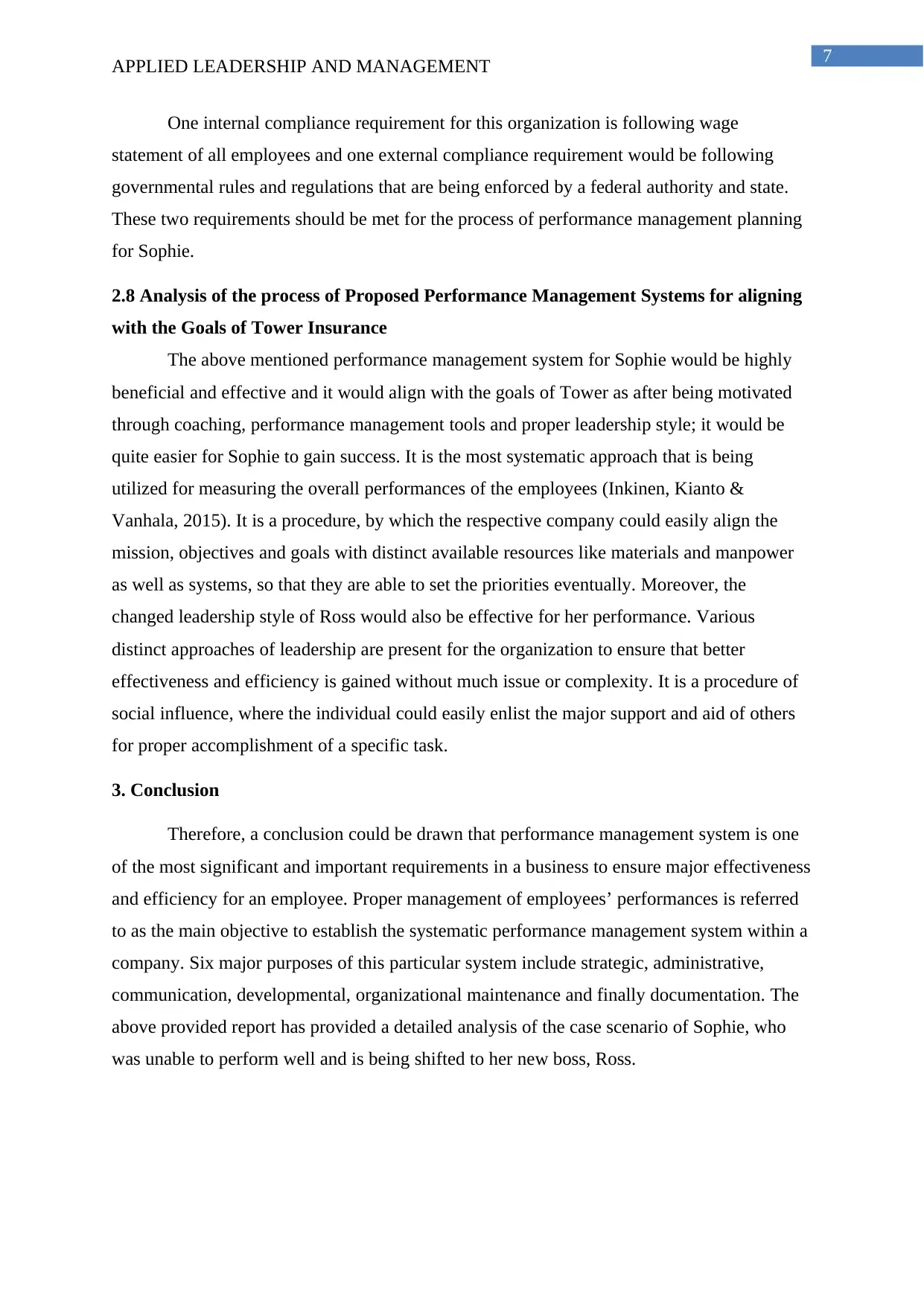
7
APPLIED LEADERSHIP AND MANAGEMENT
One internal compliance requirement for this organization is following wage
statement of all employees and one external compliance requirement would be following
governmental rules and regulations that are being enforced by a federal authority and state.
These two requirements should be met for the process of performance management planning
for Sophie.
2.8 Analysis of the process of Proposed Performance Management Systems for aligning
with the Goals of Tower Insurance
The above mentioned performance management system for Sophie would be highly
beneficial and effective and it would align with the goals of Tower as after being motivated
through coaching, performance management tools and proper leadership style; it would be
quite easier for Sophie to gain success. It is the most systematic approach that is being
utilized for measuring the overall performances of the employees (Inkinen, Kianto &
Vanhala, 2015). It is a procedure, by which the respective company could easily align the
mission, objectives and goals with distinct available resources like materials and manpower
as well as systems, so that they are able to set the priorities eventually. Moreover, the
changed leadership style of Ross would also be effective for her performance. Various
distinct approaches of leadership are present for the organization to ensure that better
effectiveness and efficiency is gained without much issue or complexity. It is a procedure of
social influence, where the individual could easily enlist the major support and aid of others
for proper accomplishment of a specific task.
3. Conclusion
Therefore, a conclusion could be drawn that performance management system is one
of the most significant and important requirements in a business to ensure major effectiveness
and efficiency for an employee. Proper management of employees’ performances is referred
to as the main objective to establish the systematic performance management system within a
company. Six major purposes of this particular system include strategic, administrative,
communication, developmental, organizational maintenance and finally documentation. The
above provided report has provided a detailed analysis of the case scenario of Sophie, who
was unable to perform well and is being shifted to her new boss, Ross.
APPLIED LEADERSHIP AND MANAGEMENT
One internal compliance requirement for this organization is following wage
statement of all employees and one external compliance requirement would be following
governmental rules and regulations that are being enforced by a federal authority and state.
These two requirements should be met for the process of performance management planning
for Sophie.
2.8 Analysis of the process of Proposed Performance Management Systems for aligning
with the Goals of Tower Insurance
The above mentioned performance management system for Sophie would be highly
beneficial and effective and it would align with the goals of Tower as after being motivated
through coaching, performance management tools and proper leadership style; it would be
quite easier for Sophie to gain success. It is the most systematic approach that is being
utilized for measuring the overall performances of the employees (Inkinen, Kianto &
Vanhala, 2015). It is a procedure, by which the respective company could easily align the
mission, objectives and goals with distinct available resources like materials and manpower
as well as systems, so that they are able to set the priorities eventually. Moreover, the
changed leadership style of Ross would also be effective for her performance. Various
distinct approaches of leadership are present for the organization to ensure that better
effectiveness and efficiency is gained without much issue or complexity. It is a procedure of
social influence, where the individual could easily enlist the major support and aid of others
for proper accomplishment of a specific task.
3. Conclusion
Therefore, a conclusion could be drawn that performance management system is one
of the most significant and important requirements in a business to ensure major effectiveness
and efficiency for an employee. Proper management of employees’ performances is referred
to as the main objective to establish the systematic performance management system within a
company. Six major purposes of this particular system include strategic, administrative,
communication, developmental, organizational maintenance and finally documentation. The
above provided report has provided a detailed analysis of the case scenario of Sophie, who
was unable to perform well and is being shifted to her new boss, Ross.
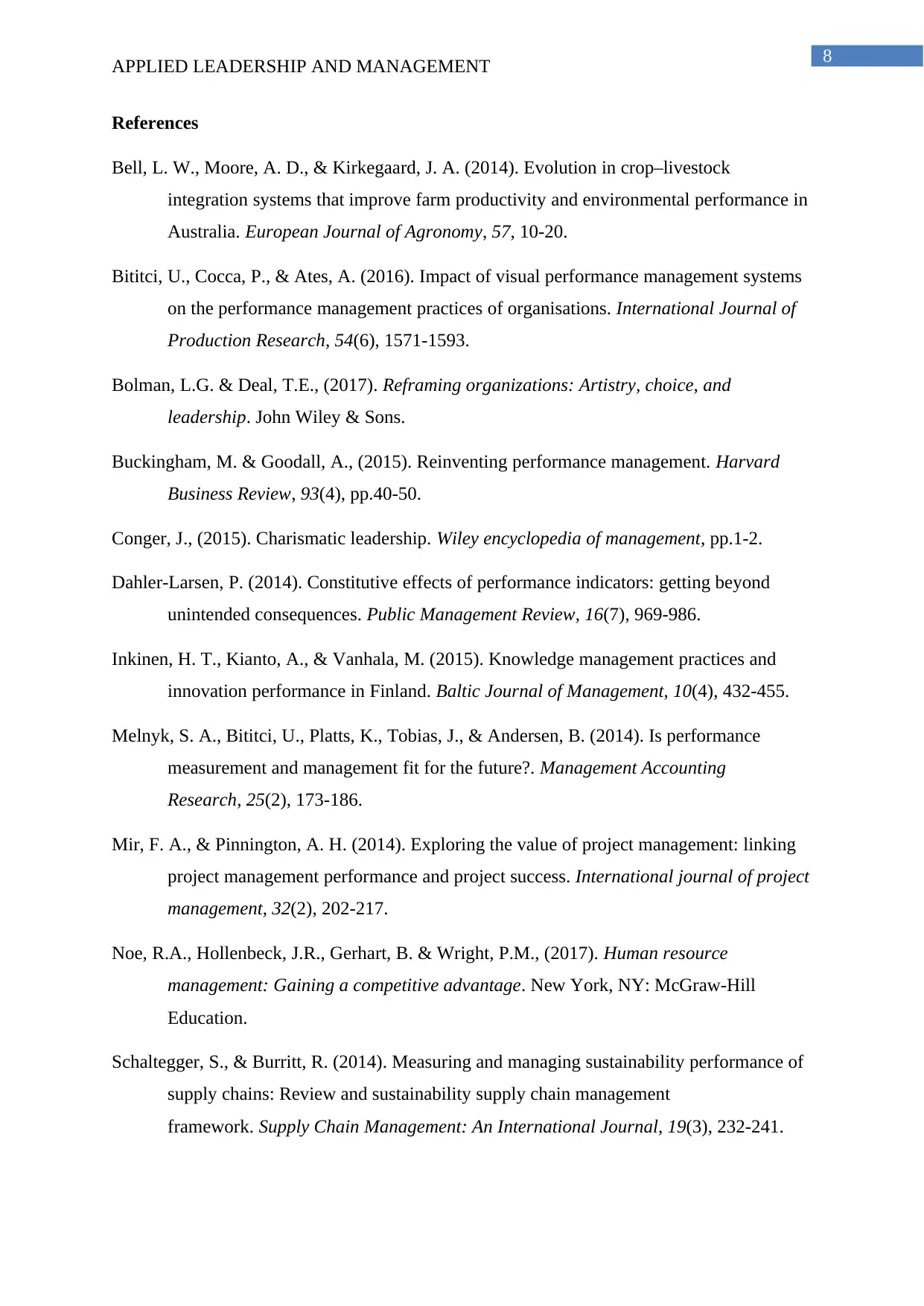
8
APPLIED LEADERSHIP AND MANAGEMENT
References
Bell, L. W., Moore, A. D., & Kirkegaard, J. A. (2014). Evolution in crop–livestock
integration systems that improve farm productivity and environmental performance in
Australia. European Journal of Agronomy, 57, 10-20.
Bititci, U., Cocca, P., & Ates, A. (2016). Impact of visual performance management systems
on the performance management practices of organisations. International Journal of
Production Research, 54(6), 1571-1593.
Bolman, L.G. & Deal, T.E., (2017). Reframing organizations: Artistry, choice, and
leadership. John Wiley & Sons.
Buckingham, M. & Goodall, A., (2015). Reinventing performance management. Harvard
Business Review, 93(4), pp.40-50.
Conger, J., (2015). Charismatic leadership. Wiley encyclopedia of management, pp.1-2.
Dahler-Larsen, P. (2014). Constitutive effects of performance indicators: getting beyond
unintended consequences. Public Management Review, 16(7), 969-986.
Inkinen, H. T., Kianto, A., & Vanhala, M. (2015). Knowledge management practices and
innovation performance in Finland. Baltic Journal of Management, 10(4), 432-455.
Melnyk, S. A., Bititci, U., Platts, K., Tobias, J., & Andersen, B. (2014). Is performance
measurement and management fit for the future?. Management Accounting
Research, 25(2), 173-186.
Mir, F. A., & Pinnington, A. H. (2014). Exploring the value of project management: linking
project management performance and project success. International journal of project
management, 32(2), 202-217.
Noe, R.A., Hollenbeck, J.R., Gerhart, B. & Wright, P.M., (2017). Human resource
management: Gaining a competitive advantage. New York, NY: McGraw-Hill
Education.
Schaltegger, S., & Burritt, R. (2014). Measuring and managing sustainability performance of
supply chains: Review and sustainability supply chain management
framework. Supply Chain Management: An International Journal, 19(3), 232-241.
APPLIED LEADERSHIP AND MANAGEMENT
References
Bell, L. W., Moore, A. D., & Kirkegaard, J. A. (2014). Evolution in crop–livestock
integration systems that improve farm productivity and environmental performance in
Australia. European Journal of Agronomy, 57, 10-20.
Bititci, U., Cocca, P., & Ates, A. (2016). Impact of visual performance management systems
on the performance management practices of organisations. International Journal of
Production Research, 54(6), 1571-1593.
Bolman, L.G. & Deal, T.E., (2017). Reframing organizations: Artistry, choice, and
leadership. John Wiley & Sons.
Buckingham, M. & Goodall, A., (2015). Reinventing performance management. Harvard
Business Review, 93(4), pp.40-50.
Conger, J., (2015). Charismatic leadership. Wiley encyclopedia of management, pp.1-2.
Dahler-Larsen, P. (2014). Constitutive effects of performance indicators: getting beyond
unintended consequences. Public Management Review, 16(7), 969-986.
Inkinen, H. T., Kianto, A., & Vanhala, M. (2015). Knowledge management practices and
innovation performance in Finland. Baltic Journal of Management, 10(4), 432-455.
Melnyk, S. A., Bititci, U., Platts, K., Tobias, J., & Andersen, B. (2014). Is performance
measurement and management fit for the future?. Management Accounting
Research, 25(2), 173-186.
Mir, F. A., & Pinnington, A. H. (2014). Exploring the value of project management: linking
project management performance and project success. International journal of project
management, 32(2), 202-217.
Noe, R.A., Hollenbeck, J.R., Gerhart, B. & Wright, P.M., (2017). Human resource
management: Gaining a competitive advantage. New York, NY: McGraw-Hill
Education.
Schaltegger, S., & Burritt, R. (2014). Measuring and managing sustainability performance of
supply chains: Review and sustainability supply chain management
framework. Supply Chain Management: An International Journal, 19(3), 232-241.
⊘ This is a preview!⊘
Do you want full access?
Subscribe today to unlock all pages.

Trusted by 1+ million students worldwide
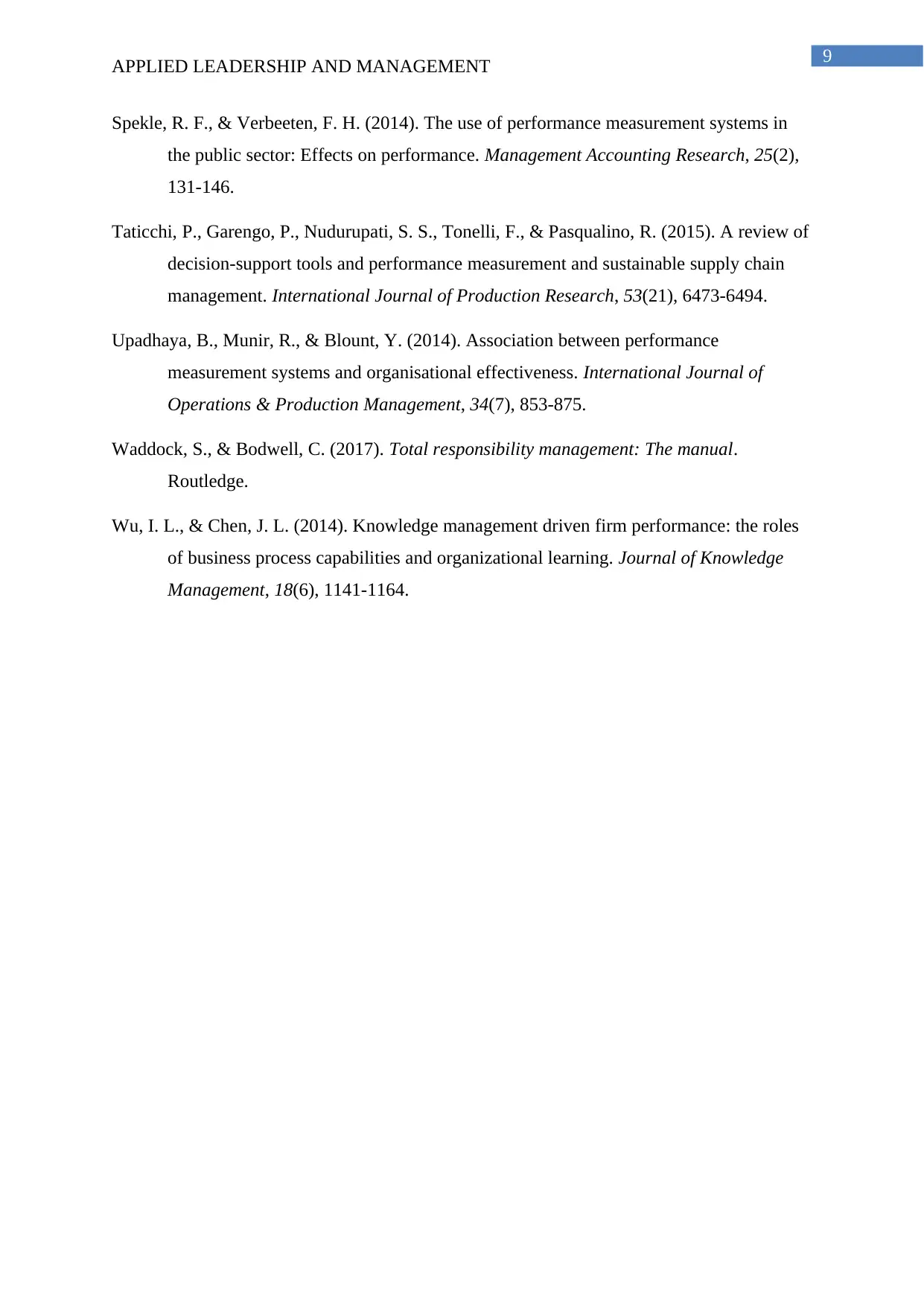
9
APPLIED LEADERSHIP AND MANAGEMENT
Spekle, R. F., & Verbeeten, F. H. (2014). The use of performance measurement systems in
the public sector: Effects on performance. Management Accounting Research, 25(2),
131-146.
Taticchi, P., Garengo, P., Nudurupati, S. S., Tonelli, F., & Pasqualino, R. (2015). A review of
decision-support tools and performance measurement and sustainable supply chain
management. International Journal of Production Research, 53(21), 6473-6494.
Upadhaya, B., Munir, R., & Blount, Y. (2014). Association between performance
measurement systems and organisational effectiveness. International Journal of
Operations & Production Management, 34(7), 853-875.
Waddock, S., & Bodwell, C. (2017). Total responsibility management: The manual.
Routledge.
Wu, I. L., & Chen, J. L. (2014). Knowledge management driven firm performance: the roles
of business process capabilities and organizational learning. Journal of Knowledge
Management, 18(6), 1141-1164.
APPLIED LEADERSHIP AND MANAGEMENT
Spekle, R. F., & Verbeeten, F. H. (2014). The use of performance measurement systems in
the public sector: Effects on performance. Management Accounting Research, 25(2),
131-146.
Taticchi, P., Garengo, P., Nudurupati, S. S., Tonelli, F., & Pasqualino, R. (2015). A review of
decision-support tools and performance measurement and sustainable supply chain
management. International Journal of Production Research, 53(21), 6473-6494.
Upadhaya, B., Munir, R., & Blount, Y. (2014). Association between performance
measurement systems and organisational effectiveness. International Journal of
Operations & Production Management, 34(7), 853-875.
Waddock, S., & Bodwell, C. (2017). Total responsibility management: The manual.
Routledge.
Wu, I. L., & Chen, J. L. (2014). Knowledge management driven firm performance: the roles
of business process capabilities and organizational learning. Journal of Knowledge
Management, 18(6), 1141-1164.
1 out of 10
Related Documents
Your All-in-One AI-Powered Toolkit for Academic Success.
+13062052269
info@desklib.com
Available 24*7 on WhatsApp / Email
![[object Object]](/_next/static/media/star-bottom.7253800d.svg)
Unlock your academic potential
Copyright © 2020–2025 A2Z Services. All Rights Reserved. Developed and managed by ZUCOL.





